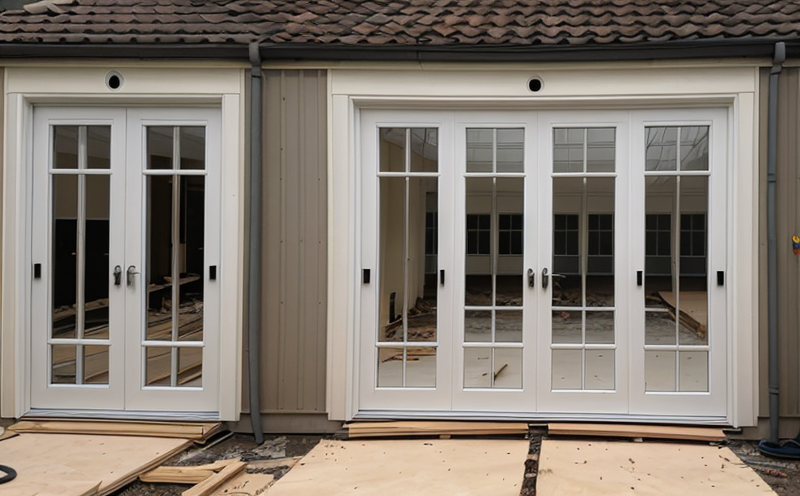Fire Resistance Testing of Fire-Rated Partitions
The fire resistance testing of fire-rated partitions is a critical component in ensuring that buildings meet stringent safety standards. These partitions are designed to provide a barrier against the spread of fire and smoke, protecting occupants from harm during emergencies. This service is essential for architects, engineers, construction professionals, and building owners who must adhere to local and international fire codes.
Fire resistance testing involves subjecting fire-rated partitions to controlled exposure to high temperatures and flames over specified durations. The test aims to determine the partition's ability to maintain its integrity, resist heat transfer, and prevent the passage of smoke and flame. This process is governed by standards such as ASTM E119, EN 1363-3, and ISO 834.
The testing setup typically includes a furnace that can generate temperatures up to 1200°C (2200°F). Specimens are placed in the furnace for durations ranging from 30 minutes to several hours, depending on the specific standard being followed. During this period, critical parameters such as temperature rise, heat flux, and flame spread are monitored continuously.
Specimen preparation is crucial; it involves selecting appropriate materials and constructing partitions that adhere to design specifications. The materials used must be compatible with the intended fire resistance rating (FRR), which ranges from 30 minutes to several hours. Proper installation of the specimen in the furnace ensures accurate testing results.
The instrumentation used during these tests includes thermocouples, infrared cameras, and flame detectors. These tools provide real-time data on temperature distribution across the partition surface and inside the compartment it separates. The data collected is analyzed using specialized software to evaluate compliance with the test criteria.
After testing, the results are summarized in a comprehensive report that details the performance of the fire-rated partition under specific conditions. This report serves as evidence for meeting regulatory requirements and provides valuable insights into potential improvements or adjustments needed during design phases.
The importance of this service cannot be overstated. It ensures not only compliance with building codes but also enhances overall safety by providing robust protection against fires. By investing in thorough fire resistance testing, stakeholders can build trust among occupants while ensuring long-term structural integrity and occupant safety.
Why It Matters
Fire resistance testing of fire-rated partitions is vital for several reasons:
- Legal Compliance: Many jurisdictions require that buildings incorporate fire-rated partitions to comply with local codes. Non-compliance can lead to significant penalties.
- Safety: Fire-resistant partitions serve as critical barriers in preventing the spread of flames and smoke, thereby saving lives during emergencies.
- Insurance Benefits: Demonstrating compliance through rigorous testing can lower insurance premiums by showcasing proactive safety measures.
- Reputation: Successful completion of these tests enhances a company's reputation for quality and reliability in the industry.
In summary, fire resistance testing is not just about meeting regulatory requirements; it’s about creating safer environments that contribute to public welfare and business success.
Quality and Reliability Assurance
Ensuring high-quality and reliable results from fire resistance tests requires meticulous planning and execution. Our laboratory adheres strictly to international standards like ASTM E119, EN 1363-3, and ISO 834, which outline the procedures for conducting these tests accurately.
We employ experienced technicians who are trained in handling complex equipment and interpreting data correctly. Each test is conducted under controlled conditions to ensure consistency and repeatability. This approach guarantees that every specimen tested receives impartial treatment regardless of its source or intended application.
Data accuracy is paramount, so we use state-of-the-art instrumentation such as high-resolution infrared cameras for precise temperature measurements and advanced computational models for predicting thermal behavior accurately. These tools help us identify potential weaknesses early on, allowing for corrective actions before the final report is issued.
Our commitment to quality extends beyond just technical aspects; it also includes rigorous documentation practices. Every test has a detailed log that records all relevant information, from initial setup to completion. This transparency allows stakeholders to verify our findings independently if needed.
In conclusion, by adhering strictly to international standards and leveraging cutting-edge technology, we deliver consistent, reliable results that instill confidence in our clients' decisions regarding fire safety measures.
Environmental and Sustainability Contributions
The environmental impact of fire resistance testing should not be overlooked. While the primary goal is to enhance building safety, there are also broader implications related to sustainability:
Eco-Friendly Materials: Using sustainable materials in fire-rated partitions can reduce carbon footprints associated with construction projects. Our laboratory works closely with suppliers who provide eco-friendly options without compromising on performance.
Energy Efficiency: Fire-resistant partitions contribute positively to energy efficiency by reducing the need for additional cooling or heating measures within protected areas. This reduces overall operational costs and contributes to greener operations.
Material Recycling: After testing, some materials can be recycled effectively without affecting their fire-resistance properties. This practice minimizes waste generation while maintaining product integrity.
By integrating these practices into our services, we strive to offer solutions that are not only safe but also environmentally responsible. Our aim is to promote sustainable development within the industry by setting new benchmarks for green building practices.





